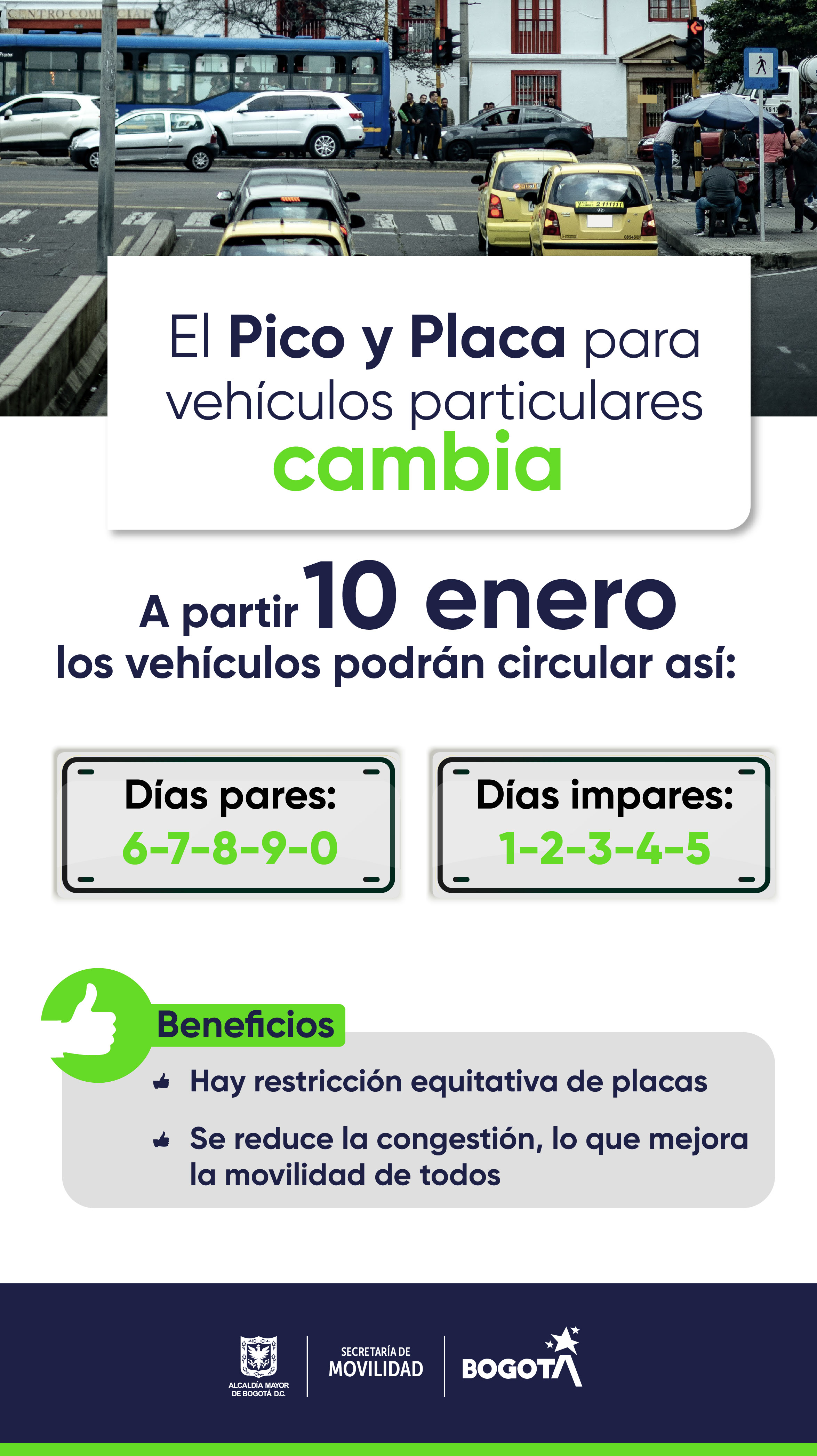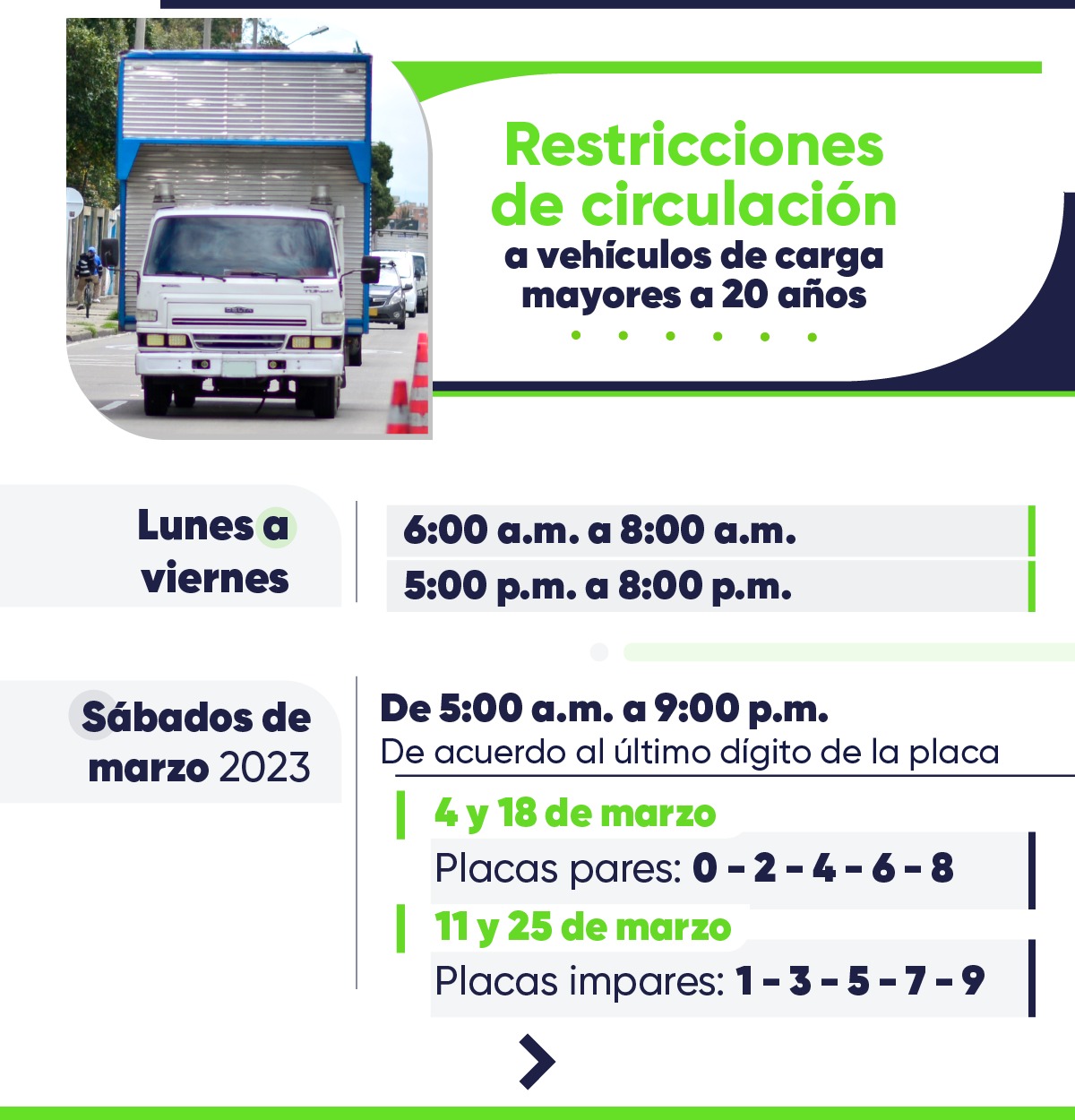Pico Y Placa Bogotá Hoy: Restricciones De Tráfico Actualizadas Para Una Circulación Fluida
Editor's Notes: "Pico Y Placa Bogotá Hoy: Restricciones De Tráfico Actualizadas Para Una Circulación Fluida" have published today date. This is a critical topic for anyone who drives in Bogotá, as it provides up-to-date information on the city's traffic restrictions.
We have analyzed the latest data and put together this guide to help you understand the Pico Y Placa regulations and how they affect you.
Key differences or Key takeways
| Day | Last digit of license plate number |
| Monday | 1 and 2 |
| Tuesday | 3 and 4 |
| Wednesday | 5 and 6 |
| Thursday | 7 and 8 |
| Friday | 9 and 0 |
Transition to main article topics
FAQ
Consult the Frequently Asked Questions (FAQs) segment below to attain further insights and address any lingering uncertainties regarding the implementation of the "Pico Y Placa" traffic restriction policy in Bogota.

Pico y placa para vehículos particulares - 2023 | Secretaría Distrital - Source www.movilidadbogota.gov.co
Question 1: What is the "Pico Y Placa" policy and how does it function?
The "Pico Y Placa" policy refers to daily traffic restrictions implemented in Bogota, whereby vehicles with specific license plate numbers are prohibited from operating during designated hours on weekdays. The restriction applies from Monday to Friday and targets vehicles based on the final digit of their license plate.
Question 2: Which vehicles are affected by the "Pico Y Placa" restriction?
The "Pico Y Placa" restriction encompasses all non-exempt private vehicles, including cars, motorcycles, and taxis. Hybrid and electric vehicles, as well as vehicles driven by individuals with disabilities, are exempt from the policy.
Question 3: What are the operating hours of the "Pico Y Placa" restriction?
The "Pico Y Placa" restriction operates during two daily time slots: from 6:00 AM to 9:00 AM and from 3:00 PM to 7:00 PM.
Question 4: How can I determine the restriction schedule for my vehicle?
The "Pico Y Placa" restriction schedule is dependent on the final digit of a vehicle's license plate. Vehicles with license plates ending in even numbers (0, 2, 4, 6, 8) are restricted on Mondays, Wednesdays, and Fridays, while vehicles with license plates ending in odd numbers (1, 3, 5, 7, 9) are restricted on Tuesdays, Thursdays, and Saturdays.
Question 5: What are the penalties for violating the "Pico Y Placa" restriction?
Violations of the "Pico Y Placa" restriction may result in a significant fine, as well as the potential immobilization of the offending vehicle.
Question 6: Where can I obtain additional information about the "Pico Y Placa" policy?
To acquire further details and stay abreast of any updates pertaining to the "Pico Y Placa" policy, it is recommended to visit the official website of the Bogota Transit Authority.
By adhering to the "Pico Y Placa" traffic restriction policy, motorists actively contribute to alleviating traffic congestion and enhancing the overall flow of vehicular movement within Bogota.
Proceed to the following article section for further insights into Bogota's transportation system.
Tips for Navigating Pico Y Placa Restrictions in Bogotá
Pico Y Placa, a traffic restriction system implemented in Bogotá, aims to reduce congestion and improve air quality. Pico Y Placa Bogotá Hoy: Restricciones De Tráfico Actualizadas Para Una Circulación Fluida Understanding these restrictions is crucial for smooth travel within the city. Here are some practical tips to help you navigate Pico Y Placa effectively:
Tip 1: Determine Your Restriction Days
Pico Y Placa restrictions vary depending on the last digit of your license plate. Odd-numbered plates are restricted on odd-numbered days, while even-numbered plates are restricted on even-numbered days.
Tip 2: Check Restriction Hours
Restrictions are enforced during two morning and two evening peak hours: 6:00-9:00 AM and 4:00-7:30 PM. Plan your trips accordingly to avoid potential delays.
Tip 3: Explore Public Transportation
During restriction hours, consider using Bogotá's extensive public transportation system, including buses, TransMilenio, and Uber. This option is cost-effective and eliminates the hassle of finding parking.
Tip 4: Carpool with Others
Carpooling, especially with colleagues or neighbors, allows you to share the ride with those who have different plate restrictions, maximizing vehicle usage and minimizing traffic.
Tip 5: Utilize Exemptions
Certain vehicles are exempt from Pico Y Placa restrictions, including emergency services, public buses, and electric vehicles. Familiarize yourself with the exemptions to determine if you qualify.
Summary:
Navigating Pico Y Placa in Bogotá requires strategic planning and awareness of the regulations. By following these tips, you can minimize traffic delays, reduce your carbon footprint, and contribute to the overall fluidity of the city's transportation system.
Pico Y Placa Bogotá Hoy: Restricciones De Tráfico Actualizadas Para Una Circulación Fluida
This article explores the key aspects of the recently updated Pico y Placa traffic restrictions in Bogotá, Colombia, to enhance traffic flow and alleviate congestion. These aspects cover the regulation´s scope, exemptions, enforcement measures, public transportation alternatives, and environmental impact.
- Scope: Pico y Placa applies to private vehicles with license plates ending in specific digits on designated days and hours.
- Exemptions: Vehicles used for public transportation, emergency services, and specific commercial activities are exempted.
- Enforcement: Electronic surveillance cameras and traffic officers monitor compliance, issuing penalties for violations.
- Public Transportation: The city offers a comprehensive public transportation system including buses, TransMilenio, and taxis to facilitate出行.
- Environmental Impact: Reducing traffic congestion improves air quality and reduces greenhouse gas emissions.
- Congestion Mitigation: Pico y Placa effectively distributes traffic flow throughout the day, optimizing road capacity.
The effective implementation of Pico y Placa in Bogotá highlights the importance of collaborative efforts between authorities and citizens to address urban mobility challenges. Its success in reducing congestion and improving air quality serves as an example for other cities seeking sustainable traffic management solutions.

Este será el pico y placa para vehículos de carga en marzo en Bogotá - Source www.radiosantafe.com
Pico Y Placa Bogotá Hoy: Restricciones De Tráfico Actualizadas Para Una Circulación Fluida
The "Pico Y Placa Bogotá Hoy: Restricciones De Tráfico Actualizadas Para Una Circulación Fluida" is a key component in the larger effort to streamline traffic flow and reduce congestion within Bogotá. This measure, which restricts the use of certain vehicles on specific days and times based on their license plate numbers, plays a vital role in improving air quality, enhancing road safety, and promoting sustainable transportation.

Pico y Placa Ibagué 2023: restricciones y rutas alternas | Autolab - Source autolab.com.co
Understanding the connection between traffic restrictions and enhanced circulation is crucial for several reasons. First, it highlights the importance of traffic management as a means of improving the overall quality of life for urban residents. By reducing congestion and improving air quality, these measures contribute to a healthier and more pleasant living environment. Second, it demonstrates the effectiveness of data-driven approaches to traffic management. The use of real-time traffic data and analytics allows authorities to tailor traffic restrictions to specific areas and times, ensuring maximum effectiveness.
The practical significance of understanding this connection extends to several key areas. It enables policymakers to develop more informed and effective traffic management strategies, leading to reduced congestion, improved air quality, and enhanced public health. Additionally, it empowers citizens to make informed decisions about their daily出行patterns, choosing alternative transportation options or adjusting their travel times to avoid restrictions.
| Día | Hora Pico Mañana | Hora Pico Tarde |
|---|---|---|
| Lunes | 6:00 AM - 8:30 AM | 3:00 PM - 7:30 PM |
| Martes | 6:00 AM - 8:30 AM | 3:00 PM - 7:30 PM |
| Miércoles | 6:00 AM - 8:30 AM | 3:00 PM - 7:30 PM |
| Jueves | 6:00 AM - 8:30 AM | 3:00 PM - 7:30 PM |
| Viernes | 6:00 AM - 8:30 AM | 3:00 PM - 7:30 PM |
| Sábado | No hay restricción | No hay restricción |
| Domingo | No hay restricción | No hay restricción |
Conclusion
The "Pico Y Placa Bogotá Hoy: Restricciones De Tráfico Actualizadas Para Una Circulación Fluida" is a testament to the positive impact that data-driven traffic management strategies can have on urban environments. By understanding the connection between traffic restrictions and enhanced circulation, policymakers can develop more effective measures to reduce congestion, improve air quality, and promote sustainable transportation. As cities continue to grow and traffic congestion becomes an increasingly pressing issue, the insights gained from this exploration will be invaluable in shaping future traffic management policies and improving the overall quality of life for urban residents.
The ongoing challenge lies in adapting these strategies to the unique needs and characteristics of each city. By leveraging real-time data, employing innovative technologies, and engaging with the public, cities can tailor their traffic management approaches to achieve optimal results. The future of traffic management holds great promise for creating more livable and sustainable urban environments, and the lessons learned from "Pico Y Placa Bogotá Hoy: Restricciones De Tráfico Actualizadas Para Una Circulación Fluida" will undoubtedly contribute to this vision.